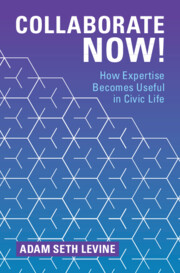Book contents
- Collaborate Now!
- Collaborate Now!
- Copyright page
- Contents
- Figures
- Tables
- Acknowledgments
- 1 Expertise and Collaborative Relationships in Civic Life
- 2 A Theory of Relationality
- 3 Relationality in Practice
- 4 The Link between Relationality and Collaborative Relationships
- 5 Surfacing and Meeting Unmet Desire for New Collaborative Relationships
- 6 Moving Forward
- Book part
- References
- Index
6 - Moving Forward
How to “Collaborate Now!”
Published online by Cambridge University Press: 14 March 2024
- Collaborate Now!
- Collaborate Now!
- Copyright page
- Contents
- Figures
- Tables
- Acknowledgments
- 1 Expertise and Collaborative Relationships in Civic Life
- 2 A Theory of Relationality
- 3 Relationality in Practice
- 4 The Link between Relationality and Collaborative Relationships
- 5 Surfacing and Meeting Unmet Desire for New Collaborative Relationships
- 6 Moving Forward
- Book part
- References
- Index
Summary
This chapter summarizes the main findings of the book, and then presents a tool called an unmet desire survey (designed based on those findings) that potential collaborators and organizational leaders can use in order to form new collaborative relationships. It also briefly discusses how the findings are helpful for forming new research partnerships, a type of formal collaboration discussed in greater detail in one of the appendices. Last, it includes several policy recommendations for how organizational leaders can put the results into practice, as well as science policy recommendations for valuable future research on the unmet desire to collaborate in civic life.
Keywords
- Type
- Chapter
- Information
- Collaborate Now!How Expertise Becomes Useful in Civic Life, pp. 145 - 170Publisher: Cambridge University PressPrint publication year: 2024

